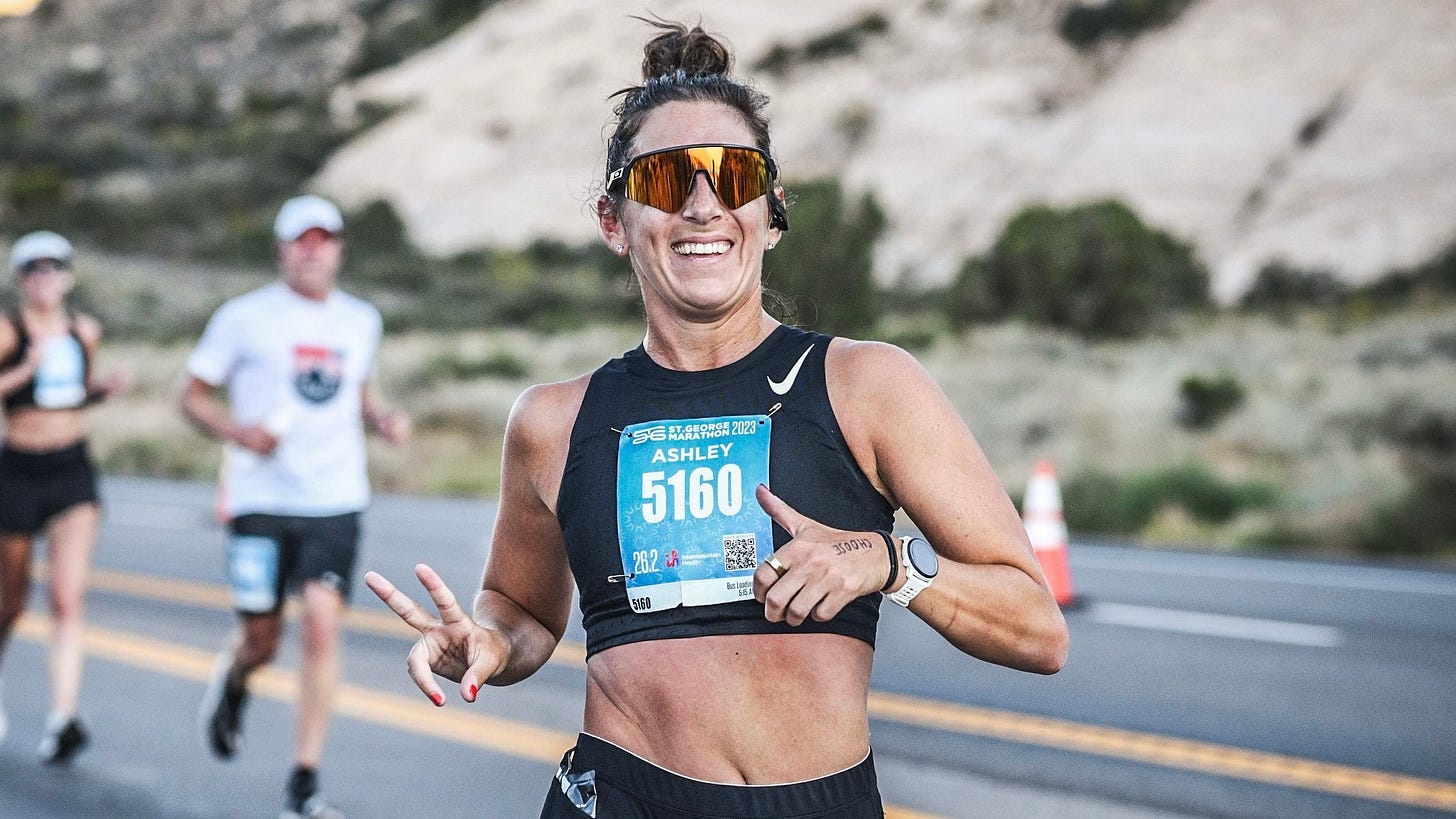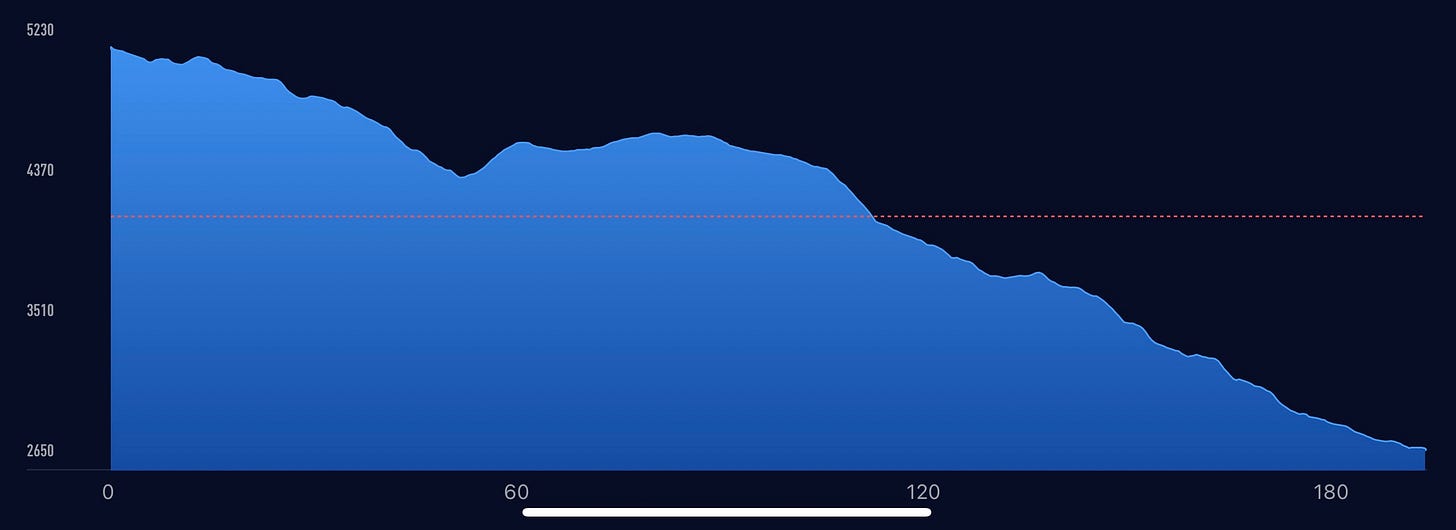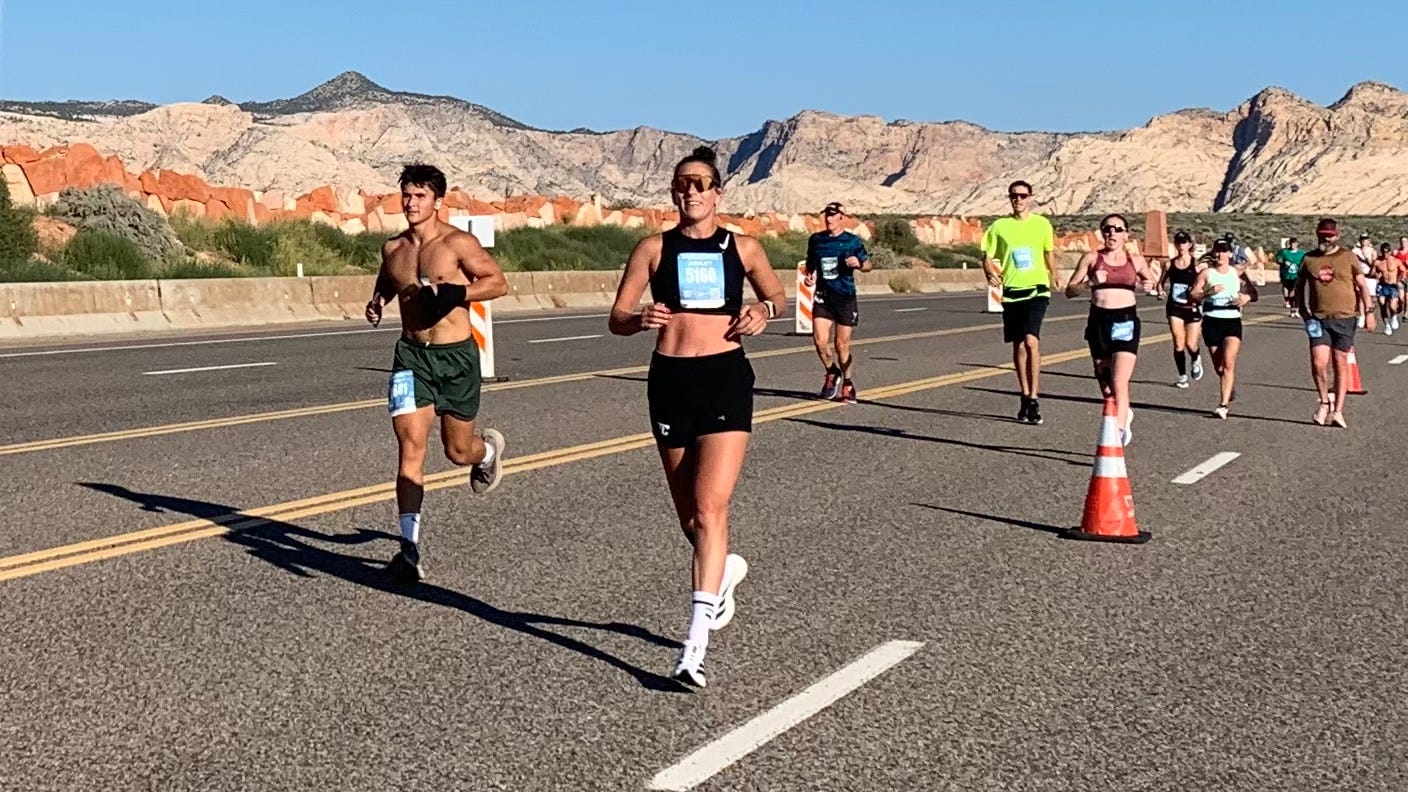St. George Marathon Recap
This downhill course through Utah’s otherworldly landscape is a 10/10.
I ran a PR at the St. George Marathon this weekend! If you’re surprised because I didn’t post anything on social media about registering or training for this race ahead of time, well, I did that on purpose.
After earning my sixth star at the Tokyo Marathon last year, I was kind of burned out on marathoning. When I worked at Shape magazine, I was invited to run the 2016 Boston Marathon; I loved the challenge of the distance, and how running made me feel. Since then, running has become an even bigger part of my job—I’ve run all the Majors thanks to New Balance, ASICS, Nike, and Adidas, I’ve written about my experiences in all kinds of publications, I studied for and received two coaching certifications, and I’ve coached multiple athletes to their own PRs. But the more involved I got in the running community, the harder it became for me to separate my love of running with the idea of running as work.
Big marathon weekends are a whirlwind for any runner—even so when you’re there representing a publication or on behalf of a brand. You’re going to events, networking, doing interviews, documenting everything for later . Don’t get me wrong, I love it. But it’s also a lot of stress! And it can be really hard to juggle all that and chase after big performance goals.
Plus, on social media, so many runners share their big goals, their weekly mileage, their paces; to keep up, I felt a little bit like I had to prove I was a certain kind of runner—one that was fast enough, did enough races, looked a certain way in fitness gear—in order to prove my value within that community. There’s research that shows people who shared health-related data on Instagram felt pressure to perform, which led to compulsive tendencies, according to a 2021 study published in the journal Social Media & Society. And, whew, the comparison (even when it’s just internal) that comes along with that—it’s a lot.
After I ran the Tokyo Marathon last spring, I knew I wasn’t done marathoning—but I also wanted to race without putting all that external pressure on myself (because I know I’m doing it to myself). I decided to sign up for a smaller race closer to home, one that had no ties to work and where I could minimize the self-imposed stress around it. I wanted to run a race just for me.
St. George hit all the markers: I could drive and turn it into a fun road trip, it was a similar environment to where I would be training, the route played to my strengths, and I could have a small support system come along with me. And while I did hope to PR in this race, I also hoped that it would remind me why I really love running, even when you strip away all the parts of it that look so glamorous on social media.
Did that make it any easier? Of course not, I still had to run 26.2 miles, which is a huge physical undertaking (I think, when you’re surrounded by runners all the time, we tend to minimize this). It’s a downhill race, with 2,517 feet of elevation loss—but a lot of sneaky rolling hills (my watch says I gained 469 feet, gross).
The first seven miles are downhill, and I wanted to use that to my advantage by starting out at goal pace—mostly because I knew I would slow down for about five miles as we climbed through Veyo, Dammeron Valley, and Diamond Valley.
Things did get dark there, and I had all the familiar feelings of wondering why I did this to myself. But my coach reminded me to skip past the negative thoughts the same way I would shuffle through songs on my playlist, and I really tried to find thoughts that would better serve me (instead of “my quads are so tired,” I tried “I’m so grateful to be here”).
My friends were waiting for me at mile 16, so once I got over the worst of the hills, my goal was to sloooowly increase my pace, as if I were turning a dial. The downhills got steeper, and I was able to turn my legs over faster again—especially after my friends dumped ice cold water on my and handed me a can of Coke.
But I had developed a side stitch around mile 10 (I’m blaming my too-upright form, but who knows; Emily Sisson had a bad one in Chicago, too—pros, they’re just like us!), and maintaining a faster pace got harder and harder. I focused on maintaining effort and trying to use gravity to my advantage, speeding up on the noticeable downhills and letting myself recover a bit on what I kept telling myself were “false hills” (because they looked worse from further away).
The entire route is on a single road, until the last two miles. I’m sure there was a part of me that was relieved when we got to the city of St. George, because that meant it was almost over, but I much preferred the scenery of the previous 24, even with minimal crowd support. There was something about the almost Martian landscape, with monolithic red and white rocks reaching into the sky and weirdly lush fields of desert shrubbery that kept me totally present in each mile.
It took a lot to power through those last few miles. Everything was starting to hurt (that’s the problem with downhill races), and I had to dig deep to remember what the hell I was doing this for. I wrote my word for this race on my hand: CHOOSE. I could choose to give up on myself and slow down, or I could choose to dig deeper and see what would happen if I tried to push through the discomfort. I definitely chose to walk at times. But I also chose to fight for the PR, and I’m really proud of that—not because of the finish time, but because of how I kept going.
This was a small race (I think there were around 6,000 marathoners), but it didn’t feel desolate. It was incredibly well-organized, and even though there were very few spectators until the end, those who were out were incredibly supportive and encouraging. I have a feeling I’ll be back…
Oh, and I did wear the Adidas Adizero Adios Pro Evo 1. Adidas says these world record-setting shoes are meant only for the most experienced and advanced runners (read: faster than me), and are only good for one race and “a familiarization period.” I did one 6.5-mile track workout—during which they felt incredible—and a two-mile shakeout run the day before the race—after which I walked home in my socks because I was paranoid about outting any extra mileage on them—and I was more than a little paranoid they might fall apart in the race (to the point where I gave my friends a back-up pair of Vaporflys to have on hand at mile 16; I did not end up needing them, whew). They felt good, but I wouldn’t go so far as to attribute the PR to the shoes. Maybe they’d feel more magical on a flat course, or on faster feet?
Anyway, I’m really proud of this PR. But I’m not proud of it because of the time, I’m proud of it because I focused on the experience first, and the performance came from that. It’s not easy to push yourself out of your comfort zone. In St. George, I managed to do that physically and mentally—and that, to me, means more than what any finisher’s certificate says.
the rundown
Molly Seidel Might Always Be a Work in Progress. She’s Totally OK With That.
Molly Seidel has been one of my favorite marathoners to follow since the 2016 U.S. Trials (I even got to interview her before the Olympics), and I’m so impressed with the candid way she’s discussed her mental health in the aftermath of her Tokyo experience. This Runner’s World article is a deep dive into her current status, and I wish more runners were willing to show this side of themselves. Clearly, it’s working for Seidel: She just ran a personal best to place eighth at the Chicago Marathon this weekend, giving herself what I’m sure was a big confidence booster heading into February’s Trials.
The Effects of Weather on Endurance Performance
Climate change is wreaking havoc on marathon conditions (the Twin Cities Marathon was recently canceled due to heat), and a 2022 study published in Medicine & Science in Sports & Exercise provides some insight into the impact of weather on performance. Temperatures between 50°F to 45.5°F increased the likelihood for peak performance, the study authors determined, and for every degree outside these optimum conditions, performance declined by 0.3–0.4 percent. No wonder I looked like I swam to the finish line in St. George, where temps started at around 55°F and reached 70°F during my race.
Dr. Marco Altini on Know Your Physio Podcast
If you like to nerd out on wearable tech, listen to this interview with Dr. Marco Altini on your next run. The founder of the HRV4Training app goes real deep into the ways stress affects performance, and how people can use their heart rate variability data to enhance their fitness and overall well-being (I finally started paying attention to this metric once I got my Oura ring). As much as I enjoy all the advanced tech, I always love hearing scientists reiterate how these devices are tools, and no matter how much info they can provide, it’s useless without the basics: proper sleep, exercise, nutrition.








When she says she's coached athletes to PRs, I can vouch for it. I literally hurt myself during the London marathon and still hit a 5 minute PR thanks to the way Ashley prepared me for the race.
Also, St. George marathon sounds awesome. It's on my list now.
I really appreciate your candidness around your own personal running experience. It really resonates with me and I’m sure lots of others.